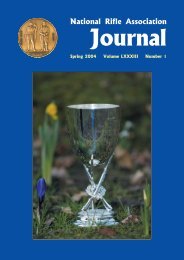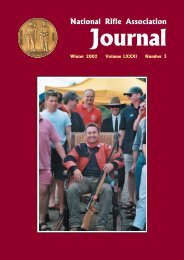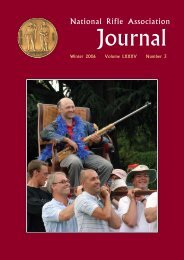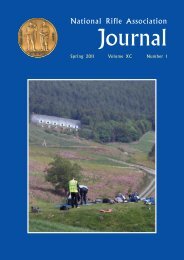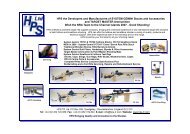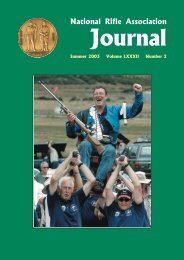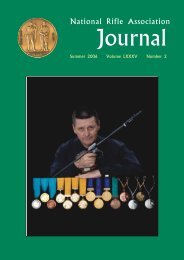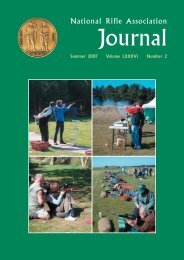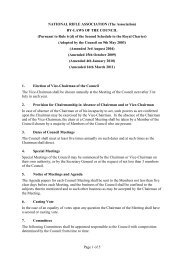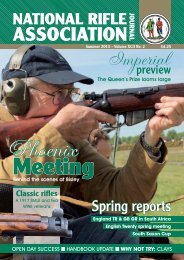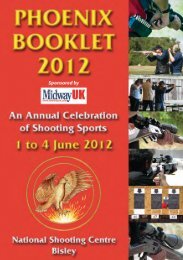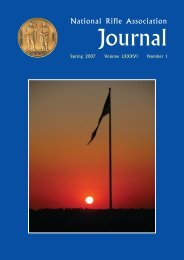NRA Journal - Summer 2004 - National Rifle Association
NRA Journal - Summer 2004 - National Rifle Association
NRA Journal - Summer 2004 - National Rifle Association
- No tags were found...
Create successful ePaper yourself
Turn your PDF publications into a flip-book with our unique Google optimized e-Paper software.
QUANTIFYING PERFORMANCEby Finbarr O’SullivanIf you were to take the scorebooks of the people whowere selected for the GB Palma team in 2003, youwould have some pretty illustrious shooting records.But if you went around Bisley with the scorebooksand asked people to eyeball the scorecards and rankthe people based on their previous, say, one year’sworth of scorecards you would end up with as manydifferent answers for ranking order as people you hadasked.Imagine the difficulty of the team selector in decidingon a squad of limited numbers from a field of manymore firers, many of whom could reasonably expecta place. Imagine the disappointment of being the onewho came closest but was dropped from such a team.Surely from scorebook comparison alone (assumingother things being equal, such as past teamperformance, how stress affects your shooting etc) youwould be forgiven for feeling that you deserved aplace as much as the last one in.Simon Belither wrote about such difficulties in theSpring <strong>2004</strong> <strong>Journal</strong>. What we set out to investigatein this article is the possibility of quantifying ashooter’s performance as an aid to team selection. Ofcourse, other less easily quantifiable factors, egamount of previous team shooting experience,performance under pressure, are very important, butin a lot of team selections these other considerationsmay not be clear cut. A quantifiable indicator of recentperformance would make it easier in somecircumstances for a team selector to convince someonewho hadn’t quite made the team that there was ajustifiable reason for the decision. You can’t arguewith the numbers.To look for such an indicator we have used scorecardsfrom nine cadets from Stamford School. MikMaksimovic was the team selector for the StamfordSchool 2003 Ashburton team and it fell to him to picka team of eight. For the purposes of the investigationthis is not as good an example as it might be becauseit would have been better illustrated by having to picka team of eight from a field of, say, 16. However, wehope at least to be able to show that a quantitativeanalysis based on grouping statistics can be a helpfulaid for team selectors.The other drawback is that for each cadet we did nothave that many scoresheets available at the time.Again, for the purposes of illustrating the techniqueit will hopefully be sufficient to illustrate the approach.To perform the analysis we use eScoreBook softwarefrom www.bluebarnacle.com. We set up the ninecadets in the system and then entered their scoresheetsfor a number of previous shoots taken over the periodof interest (in this case some practice days before theAshburton).Having entered all the plots, together with the windand elevation for each recorded shot, we are in aposition to start comparing the shooters.BackplotThe software can be used to calculate groupingstatistics either for a single scorecard or for a set ofscorecards selected according to a range of searchcriteria, and can be used to compare many firers. Forthe purposes of this analysis we are going to use allthe scorecards for each competitor (with the exceptionof the Ashburton itself of course) rather than restrictourselves to a subset.The statistics are calculated not on the recorded fallof shot but on the backplot. The backplot is atechnique where you keep track of the corrected windand elevation for each shot and then calculate theaverage corrected wind and average correctedelevation for the shoot. Then you replot the shotswhere they would have fallen if you had had theseaverages on the gun at the time and assuming all otherthings are equal, such as human error. This helps toeliminate the effect of mistakes in wind coaching andelevation changes on the appearance of the plot. Toillustrate this, we plot a real example shoot. The plotis shown in Figure 1 and the backplot is shown inFigure 3.Figure 1 Fall of ShotFigure 2 Wind and Elevation for Figure 123



